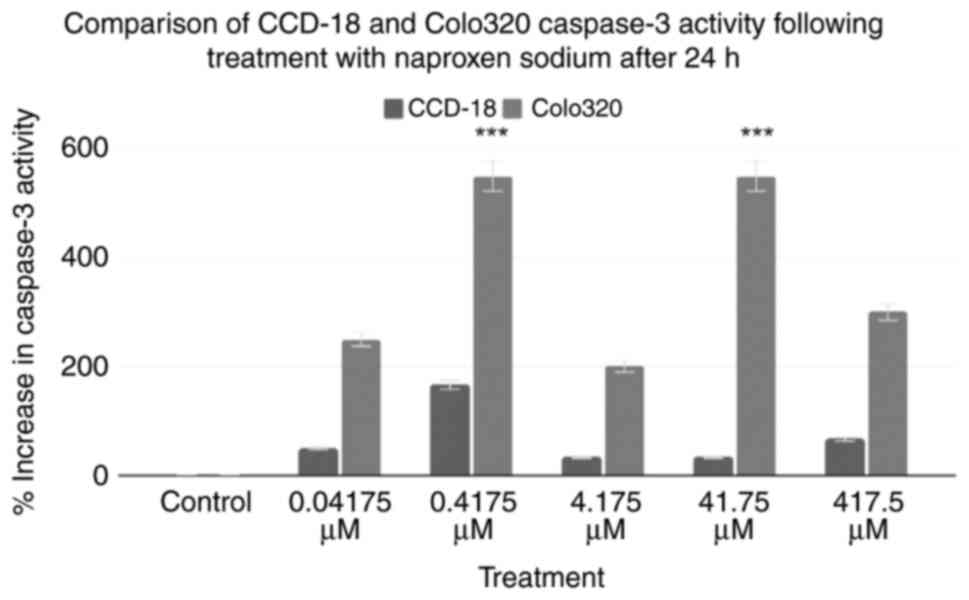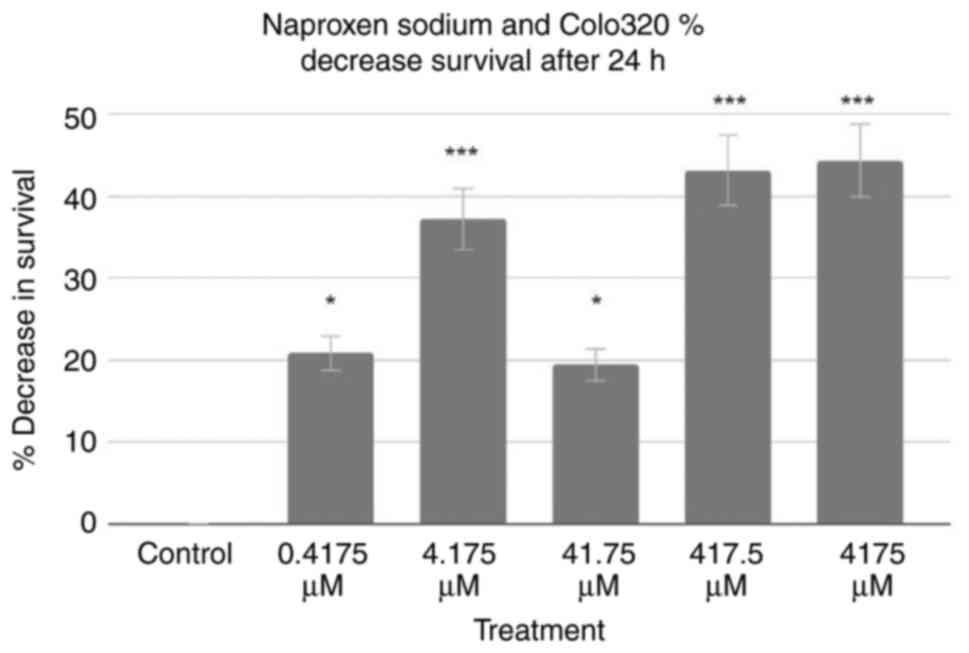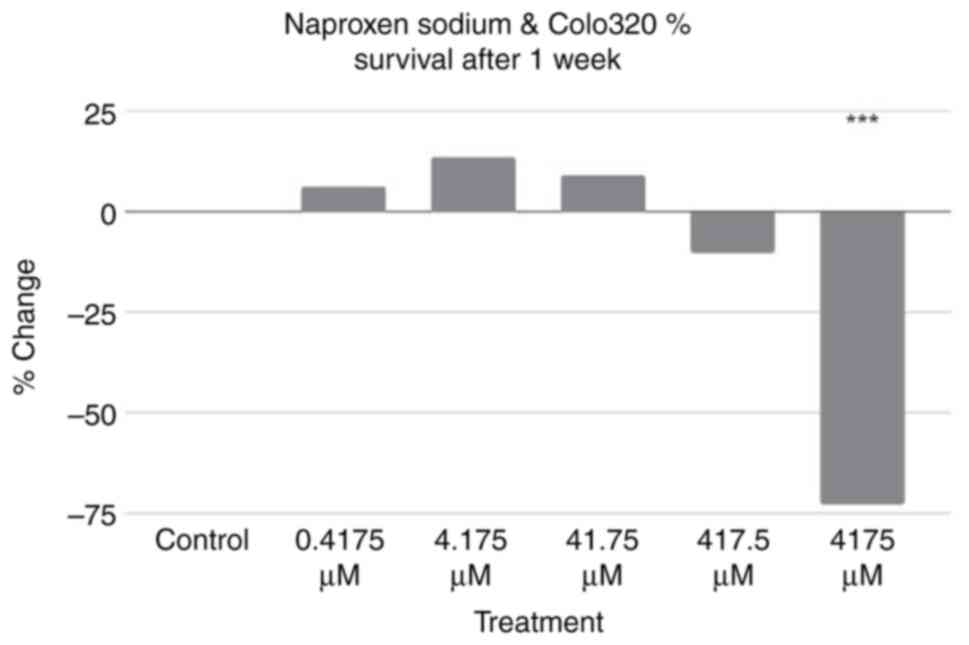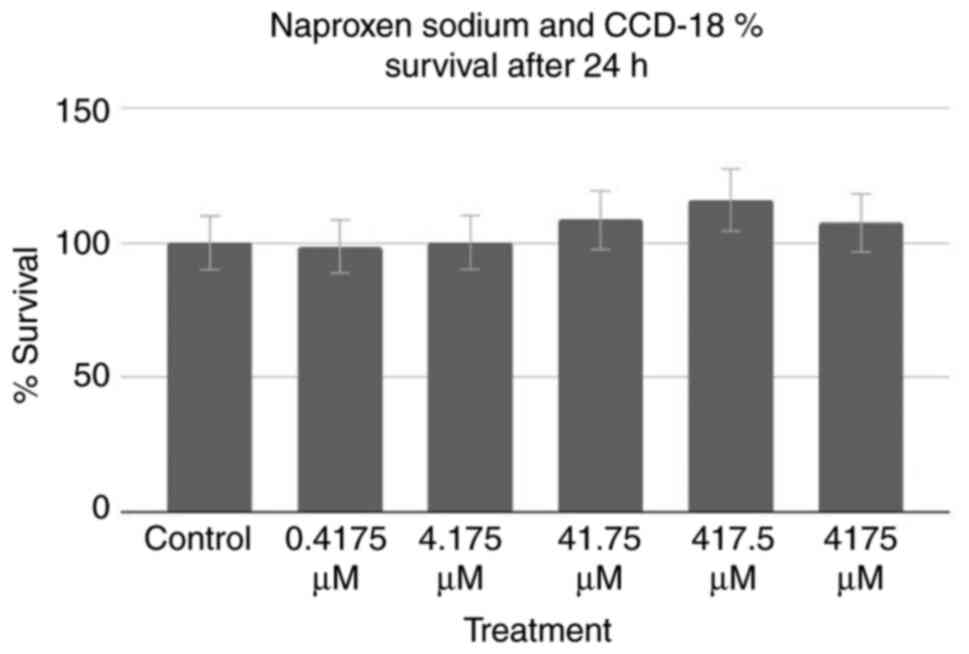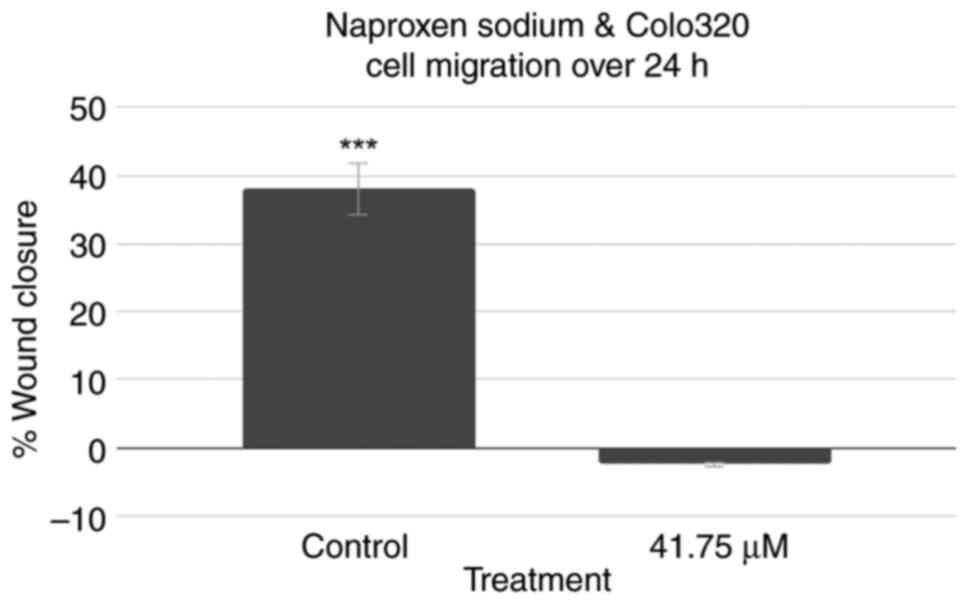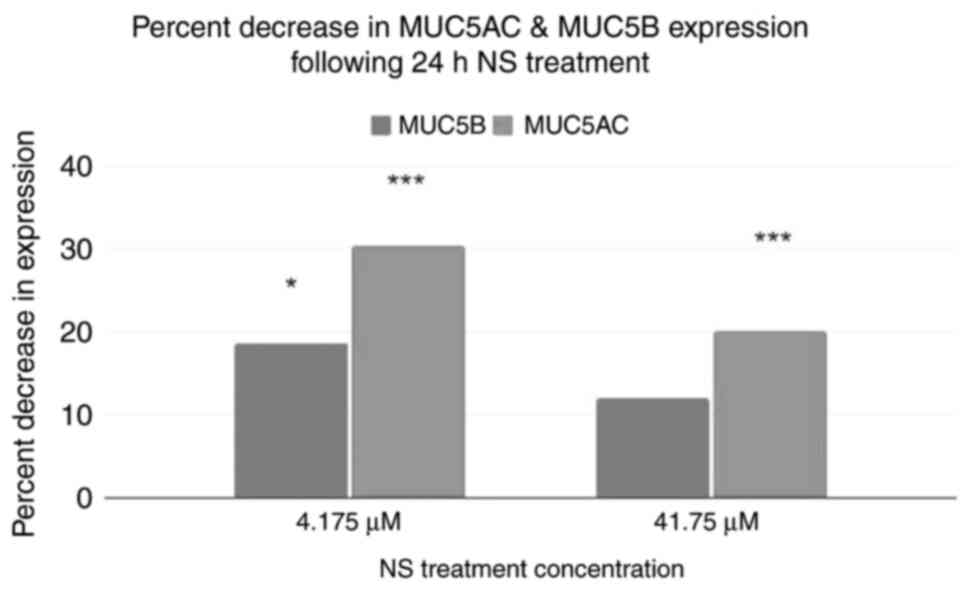Analysis of naproxen activation of cell death pathways in Colo320 cells
- Authors:
- Published online on: July 3, 2024 https://doi.org/10.3892/mco.2024.2759
- Article Number: 61
-
Copyright: © Chen et al. This is an open access article distributed under the terms of Creative Commons Attribution License.
Abstract
Introduction
Colorectal cancer, also known as colon cancer, is a type of cancer that occurs in the colon or rectum. Cells that undergo mutation may grow and divide at an unusual rate and fail to undergo standard apoptosis. Thus, such cells may develop into unnatural growths known as polyps, which if left alone, can develop into cancerous tumors (1). According to the American Society of Clinical Oncology, the current treatment methods for colorectal cancer can be categorized into three types: Surgeries, radiation therapies and medication therapies (2). Surgeries typically involve the physical removal of the cancer and are also used to mitigate certain symptoms of colorectal cancer, such as in cases where the large intestine is blocked/damaged by cancer, preventing proper exocrine function. However, such operations can also result in side effects such as constipation and diarrhea. Radiation therapy, on the other hand, removes cancer using high-frequency waves. This is often used to complement surgeries, such as by removing small tumors that are difficult to remove surgically. Side effects range from fatigue to bleeding in the rectum. Finally, treatments with medication utilize various drugs to eliminate or prevent the replication of cancer cells through chemotherapy or targeted therapy. Some medications also aim to increase the capabilities of the immune system of the body. Side effects tend to be drug-specific (2).
Naproxen (NS) is typically known for its use as a non-steroidal anti-inflammatory drug (NSAID) and has been a subject of research due to its potential use as a medical treatment in the form of chemotherapy. In 2014, a study by the Women's Health Initiative (3) concluded that NSAIDs were associated with reduced risks of colorectal cancer and could have chemopreventive effects. Possible chemopreventive effects of a hydrogen sulfide-releasing NS were also supported by a study that used a xenograft mouse model. The study also revealed that NS could inhibit growth via downregulation of NF-κB (4). In 2019, an in vivo study on rats further demonstrated the potential for aspirin and NS to fight colorectal cancer, including through enabling apoptosis via caspase-3(5). A previous study on the effects of NS in patients with Lynch syndrome, which increases the probability of developing colorectal cancer, found that NS was safe to use, boosted immune activity in humans and exerted chemopreventive effects in mice (6). While studies such as the aforementioned ones have demonstrated that NS may have chemopreventive properties, fewer studies have analyzed the association between NS and the activation of specific pathways in colon cells, such as apoptosis. In the present study, it was hypothesized that NS may have a variety of beneficial effects in fighting and limiting colorectal cancer. The present study aimed to reveal the impacts of NS on relevant biological cell pathways and its effects on cancer cell survival and proliferation.
Materials and methods
Cell culture
Colo320 (Colo 320DM; cat. no. CCL-220) and CCD-18 cells (CCD-18Co; cat. no. CRL-1459) were obtained from American Type Culture Collection and used in the experiments. The cells were cultured in cell culture flasks with Eagle's Minimum Essential Medium (MEM) supplemented with 10% FBS, both of which were supplied by Thermo Fisher Scientific, Inc. MEM was replaced weekly. Cells were incubated at 37˚C with 5% CO2. For the assays, 96-well plates contained 100 µl MEM and ~10,000 cells per well, and 6-well plates contained 2 ml MEM and ~200,000 cells per well.
Molecular docking
PyRx version 0.8 (https://pyrx.sourceforge.io/) was used for molecular docking analysis to help identify potential targets for NS in colorectal cancer cells. Images were generated of the interactions via BIOVIA Discovery Studio Visualizer v21.1.0.20298 (https://discover.3ds.com/discovery-studio-visualizer-download).
Dilutions
NS caplets (Sigma-Aldrich; Merck KGaA) dissolved in water were obtained at a concentration of 83.5 mM. Serial dilutions were used to obtain four more different concentrations of NS. These five total concentrations were then used for each assay, occasionally further diluted by differing quantities due to the differing procedures of each specific assay.
Caspase-3 assay
The caspase-3 assay (cat. no. BAQ009; G-Biosciences) was performed according to the manufacturer's protocol (7). Cells were cultured in a 6-well plate and treated with 10 µl per well of the respective chemicals at various concentrations. After treatment and incubation, the cells were collected in 1.5-ml tubes with 50 µl caspase lysis buffer and stored at -20˚C for 24 h. The assay was performed in a 96-well plate in triplicates per sample. Each well of the 96-well plate contained 50 µl caspase assay buffer, 45 µl caspase lysis buffer, 5 µl lysed sample and 5 µl caspase-3 substrate. The application ‘microplate manager 6’ version 3.2.1 by Bio-Rad Laboratories, Inc. was used to obtain absorbance data at a wavelength of 415 nm. Data points were collected every 15 min for 60 min. Percent changes in caspase-3 activity were calculated using the following equation: [(Treatment group absorbance-control absorbance)/control absorbance] x100%=% change in caspase activity.
MTT assay
Colo320 cells were seeded into a 96-well plate. Each well received 5 µl of the respective treatments. The plate was divided into six groups of 16 wells each for the five concentrations of treatments and the control. The plate was then placed in an incubator at 37˚C for two different time periods of 24 h and 1 week. For assays lasting 1 week, media were replaced and treatment was re-added at the same concentration on the fourth day. After the respective time period, 10 µl MTT was added to each well. After 90 min, 80 µl DMSO was added to each well. After ~10 min, the wells were transferred to a spectrophotometer, and ‘microplate manager 6’ was used to obtain absorbance data at a wavelength of 595 nm. The percentage cell survival was calculated using the following equation: (Treatment group absorbance/control absorbance) x100%=% cell survival.
Cell migration assay
The cell migration assay was performed only on the cancerous cell line because the cancerous cell line was the one relevant to NS's effects on the migratory ability of colorectal cancer. Colo320 cells were seeded into two 6-well plates at ~80% confluency. One plate received no treatment and the other received 10 µl of 41.75 µM NS. A total of three relatively straight, horizontal scratch lines were made on each well using a 200-µl pipette tip. Each well was provided with 2 ml Eagle's Minimum Essential Medium (MEM) supplemented with 5% fetal bovine serum (FBS), after which the plates were placed in an incubator and stored for 24 h at 37˚C. Images were captured of each well at 0 and 24 h. Measurements were made regarding the vertical distance of each scratch mark in each image using a compound light microscope [AMScope version x64, 4.8.15934.20191112 (https://amscope.com/) (AmScope) and MS Paint (Microsoft Corporation)]. The percentage of wound closure was calculated for each group using the following equation: [(0 h average distance-24 h average distance)/0 h average distance] x100%=% increase in cell distance.
RNA sequencing
RNA sequencing was selected over DNA microarray due to a variety of advantages, including avoiding systematic biases, increased number of detectable splices, and ability to detect a wider range of expression changes, as demonstrated by studies over the past decade (8,9). Similar to cell migration, the test was performed only on the cancerous cell line because the cancerous cell line was the one relevant to NS's effects on the gene expression of colorectal cancer. RNA sequencing services were provided by Azenta, Inc. Sequencing was performed using the methods listed online (https://fs.hubspotusercontent00.net/hubfs/3478602/13002-SD-2%201221%20RNA-Seq%20Technical%20Specs%20Sell%20Sheet.pdf).
ELISA
ELISA kits [Human MUC5AC (Mucin 5 Subtype AC) ELISA kit, cat.no. E-EL-H2279; and human MUC5B (Mucin 5 Subtype B) ELISA kit, cat.no. E-EL-H2280] were obtained from Elabscience Biotechnology, Inc. All reagents, apart from DI water, were provided in the kits. The ELISA was performed according to the manufacturer's protocol (10). The assay was performed in 34 wells of a 96-well plate. A total of 16 wells contained 100 µl of varying concentrations of standard; six more contained control, 4.175 or 41.75 µM NS treatments of Colo320 cells. The plate was incubated for 90 min at 37˚C. Subsequently, 100 µl Biotinylated Detection Ab working solution was added to each well, followed by 1 h of incubation. The wells were then washed three times before 100 µl HRP Conjugate working solution was added to each well and incubation was performed for another 30 min. After five more washes, 90 µl Substrate Reagent was added to each well, followed by 15 min of incubation. Finally, 50 µl Stop Solution was added to each well before the optical density was measured using ‘microplate manager 6’. The mucin 5AC, oligomeric mucus/gel-forming (MUC5AC) concentration was calculated for each treatment and the control via the equation provided by the standard curve was generated by the 16 wells of standard.
Statistical analysis
Experiments were repeated 3 times. Data were presented as the mean ± 5-10% error. For all statistical analyses including multiple groups, two-tailed one-factor ANOVA tests were performed in Microsoft Excel (Microsoft Corporation) with P<0.05 considered to indicate a statistically significant difference. For statistically significant ANOVA results, Dunnett's was used in post-hoc tests with control and performed in Microsoft Excel. In cases where ANOVA was not applicable, two-tailed t-tests were performed in Google Sheets with a 95% confidence interval and P<0.05.
Results
Binding of NS to critical molecules
Molecular docking analysis using PyRx demonstrated the potential for NS to bind to molecules relevant to colorectal cancer, including Fas receptor with a Vina binding affinity of -6.3 (PDB ID: 1DDF), TRAIL with a Vina binding affinity of -6.2 (PDB ID: 1D2Q), caspase-3 with a Vina binding affinity of -7.2 (PDB ID: 1NMS), and MMP9 with Vina binding affinities of -7 (PDB ID 1L6J), -6.8 (PDB ID 1GKD) and -6.5 (PDB ID 1GKC), as observed in Fig. S1, Fig. S2, Fig. S3, Fig. S4, Fig. S5 and Fig. S6, respectively.
Effects of NS on cell survival
Caspase-3 assays were performed on two cell lines: CCD-18 and Colo320 cells. The combined results of the caspase-3 assays are shown in Fig. 1. Using the control as a baseline, all treatment groups exhibited an increase in caspase-3 activity. The 0.04175, 0.4175, 4.175, 41.75 and 417.5 µM treatments of Colo320 cells increased caspase-3 activity by 250, 550, 200, 550 and 300%, respectively. A two-tailed ANOVA at P<0.05 demonstrated statistical significance within groups for Colo320, but not CCD18 (P=0.17, P<0.001, respectively). Post-hoc Dunnett's tests revealed that only the 0.4175 and 41.75 µM treatments for Colo320 were statistically significant (P≥0.999, P<0.001, P≥0.999, P<0.001, P=0.052, respectively).
Based on these data, MTT assays for the Colo320 cell line were performed. The results of 24-h tests are demonstrated in Fig. 2. Using the control as a baseline, all treatment groups exhibited a decrease in Colo320 cell survival. The 0.4175, 4.175, 41.75, 417.5 and 4,175 µM treatments decreased Colo320 cell survival rates by 20.86, 37.24, 19.45, 43.22 and 44.40%, respectively. A two-tailed ANOVA at P<0.05 demonstrated significance (P<0.001), and post-hoc Dunnett's tests revealed that every treatment was statistically significant (P=0.015, P<0.001, P=0.027, P<0.001 and P<0.001, respectively).
Additional assays using the same treatment conditions were performed using Colo320 cells incubated for a week rather than a day. The results are revealed in Fig. 3. Using the control as a baseline, three treatment groups exhibited an increase in percentage of cell survival, while two exhibited a decrease in percentage of cell survival. A two-tailed ANOVA at P<0.05 showed statistical significance between groups (P<0.001); a post-hoc Dunnett's test revealed that only the result of the 4,175 µM treatment was statistically significant (P=≥0.999, P=≥0.999, P=≥0.999, P=≥0.999 and P<0.001, respectively).
All aforementioned assays were performed on Colo320 cancer cells; however, assays were also performed on healthy cells to test for potentially harmful effects on surrounding non-cancerous cells. An MTT assay of healthy CCD-18 cells was performed, the results of which can be observed in Fig. 4. Using the control as a baseline, one group (0.4175 µM treatment) exhibited a decrease in percentage of cell survival, whereas the remaining four groups, and notably the groups treated with the higher half of concentrations, exhibited an increase. However, a two-tailed ANOVA at P<0.05 demonstrated no statistical significance (P=0.596).
Effects of NS on cell migration
A scratch cell migration assay was also performed using Colo320 cells to assess the effect of treatment with NS on the capability of colorectal cancer cells to regenerate and migrate. The results are demonstrated in Fig. 5. Representative images captured for the 0-h control, 0-h treatment, 24-h control and 24-h treatment wells can be observed in Fig. S7, Fig. S8, Fig. S9 and Fig. S10, respectively. While the control group exhibited a decrease in cell distance and demonstrated wound closure, the treatment group instead exhibited a slight increase in cell distance. A two-tailed t-test at P<0.05 revealed that the control group's results were statistically significant (P<0.001), while the treatment group's results were not (P=0.338).
Effects of NS on gene expression
RNA sequencing was performed to analyze the impact of NS treatment on gene expression of Colo320 cells and its potential association with the aforementioned outcomes with regards to cell survival, caspase-3 expression and cell migration. The results are revealed in Fig. 6. RNA sequencing of cells treated with NS revealed, after adjusting the P-value, that the difference in expression of exclusively three genes compared with the control samples was statistically significant. The three genes were: Mucin 5B, oligomeric mucus/gel-forming (MUC5B), S100 calcium binding protein A9 (S100A9) and MUC5AC. The log2 fold change was -1.044591508, -1.735671752 and -1.403844476, respectively, with P-values of 1.52x10-8, 1.04x10-5 and 5.55x10-10, respectively, and adjusted P-values of 1.68x10-4, 4.62x10-2 and 1.23x10-5, respectively.
An ELISA was performed to corroborate the results of RNA sequencing (Fig. 7). Using the control as a baseline, both treatment groups exhibited a decrease in MUC5AC and MUC5B protein expression. A two-tailed ANOVA showed that both MUC5AC and MUC5B levels were significantly different in response to NS treatment (P<0.001 and P=0.032). Post-hoc Dunnett's tests demonstrated that the levels of MUC5AC were significantly different in both treatment groups (P<0.001 and P<0.001), whereas MUC5B levels were only significantly different in the 4.175 µM NS group, but not in the 41.75 µM treatment group (P=0.01733 and P≥0.999).
Discussion
The caspase-3 assay suggested that treatment with NS increased caspase-3 activity in Colo320 cells, especially since no treatment resulted in a decrease in caspase-3 activity. However, this appears to contradict previous findings on the nature of NSAIDs (11). This apparent contradiction may have been due to the testing of NS in cancer cells as opposed to healthy cells, a possibility reinforced by the lack of a statistically significant increase in caspase-3 activity in most CCD-18 cell treatment groups. However, the Colo320 cell results also confirmed the previously mentioned study which found that aspirin and NS could fight colorectal cancer in rats via increased caspase-3 activity (5), as caspase-3 is a known apoptotic marker (12).
Combined with the caspase-3 assay, the results of the first MTT assay demonstrated that treatment of colorectal cancer cells with NS induced apoptosis, leading to cell death. However, the second MTT assay demonstrated that over time, the effects of the treatment weakened if the treatment was not maintained at high concentrations. Additionally, the third MTT assay discovered no evidence that NS caused any change in the survival of non-cancerous, healthy cells. This finding was also consistent with the finding of the present study that treatments with NS had no statistically significant impact on caspase-3 activity in healthy cells. These findings were reflected clearly in Figs. 1 and 2. The former revealed how all treatments resulted in a large increase in Caspase-3 activity for Colo320 cells, and how those changes were significantly smaller for CCD-18 cells. The latter revealed how all treatments of Colo320 resulted in a statistically significant decrease in cell survival.
Cell migration assay results demonstrated that NS treatment resulted in a lack of change in cell distance, implying that NS treatment resulted in decreases in the migration of Colo320 cells.
Based on RNA sequencing, the MUC5B, S100A9 and MUC5AC genes were downregulated significantly, and all three are known to be upregulated in cancer cells (13-15). While there is less known about the impact of MUC5B on cancer, it is known to be a useful biomarker and may be responsible for increased proliferation and migration of colorectal and lung cancer cells (13,16). Blocking of S100A9 is known to suppress colorectal cancer cell stemness as well as general growth (14). Lastly, overexpression of MUC5AC results in higher cell invasion and migration and is additionally known to make cancer cells more resilient by decreasing the probability of triggering apoptosis and increasing cell resistance to two important drugs for treating cancer, fluorouracil and oxaliplatin (15). Together with the caspase-3 and MTT assays of the present study, NS downregulation of all three of these genes indicates a novel explanation for NS's chemo preventive and anticancer effects that was not discovered in previous studies, which had instead suggested inhibition of COX-2, inhibition of NF-kB signaling, reduction of PGE2 and multi-caspase inhibition (3,4,6,11). This further explains how NS impacts cancerous Colo320 cells but not healthy CCD-18 colon cells.
The ELISAs further confirmed and quantified the results of RNA sequencing. Both MUC5B and MUC5AC exhibited noticeable and statistically significant decreases in expression, ranging between 11.97 and 30.33%.
These results can be explained by a CD44 and MMP9-dependent signaling pathway. Changes in MMP9 expression have been found to lead to corresponding changes in MUC5AC and MUC5B expression (17,18). Additionally, S100A9 and CD44 are known to be involved in the regulation of MMP9 (19,20). Notably, CD44 has been discovered to associate with MMP9 on the cell surface, and CD44 activity has been revealed to trigger MMP9 expression and lead to invasion (20). Hyaluronic acid-coated NS has already been tested and revealed to be able to target cells with high CD44 expression, demonstrating that CD44 may act as the initial receptor from which NS may selectively affect colorectal cancer cells (21). Furthermore, the present molecular docking analysis indicated the potential for NS to bind directly to MMP9, which may be another way NS could interact with this pathway to influence MUC5AC and MUC5B expression.
The present study has notable limitations. Firstly, there was large variance in the results of the caspase assay, such that the treatments of 4.175 and 417.5 µM for Colo320 cells were not statistically significant. Although all treatments resulted in a large increase in Caspase-3 activity for Colo320 cells, further study may be warranted to examine why the results were not linear. A similar question could be posited for the 41.75-µM treatment of Colo320 cells during the 24 h MTT assay; a linear relationship between NS concentration and Colo320 cell death would predict the aforementioned treatment to cause a larger, not a smaller, decrease in Colo320 cell survival.
Additionally, the only points at which data was collected for MTT and Caspase assays were at 24 h and 7 days. More time points between these, or tests for longer periods, could provide further insight into the present study's findings. Furthermore, other tests such as a TUNEL assay or immunohistochemistry assays for apoptotic markers could be used in the future to confirm these results.
The cell migration assay also was performed on only one treatment group. Tests utilizing multiple treatment groups of different concentrations could provide insight on the necessary concentration of NS to reach the identified effect, as well as the precise nature of the relationship between NS concentration and wound healing.
With regards to mechanism, the present study performed RNA sequencing on only Colo320 cells. RNA sequencing of CCD-18 could provide further insight into changes in gene expression between CCD-18 and Colo320, as well as provide further information on the effects of NS on healthy colorectal cells. Confirmation for the change in expression of MUC5AC and MUC5A could also be checked via a DNA microarray. Other studies, such as loss-of-function or other assays, could further improve on this via confirmation of results or analysis into other apoptosis-related genes not examined in the present study, such as Bax, Bcl-2, or Caspase 7. Such tests could also help confirm the role of the PI3K/Akt pathway, which the present study was unable to confirm (22).
Furthermore, while the results of the ELISAs were able to confirm a decrease in MUC5AC and MUC5B concentration, the decrease was less marked when the treatment concentration was increased, resulting in a lack of statistical significance for the 41.75 µM treatment group regarding MUC5B. Future tests analyzing more treatment concentrations and using larger sample sizes could be useful for better identifying the precise relationship between NS concentration and MUC5AC and MUC5B levels.
In conclusion, based on the increased caspase-3 activity and decreased survival of the tested Colo320 colon cancer cells, treatment with NS could induce apoptosis in colorectal cancer cells. Furthermore, the present study revealed no evidence that NS exhibited any such effect on healthy cells. Additionally, the results of the cell migration assay revealed that NS was capable of reducing cancer cell migration and regeneration. Based on RNA sequencing, it was hypothesized that these capabilities are due to the ability of NS to downregulate the MUC5B, S100A9 and MUC5AC genes, potentially through a CD44 and MMP9-dependent pathway, which is responsible for causing decreased cancer cell proliferation, migration, invasion, stemness and resilience to treatment with other drugs.
Supplementary Material
BIOVIA image of binding of naproxen sodium to FAS receptor (PBD ID: 1DDF).
BIOVIA image of binding of naproxen sodium to TRAIL (PBD ID: 1D2Q).
BIOVIA image of binding of naproxen sodium to caspase-3 (PBD ID: 1NMS).
BIOVIA image of binding of naproxen sodium to MMP9 (PBD ID: 1L6J).
BIOVIA image of binding of naproxen sodium to MMP9 (PDB ID: 1GKD).
BIOVIA image of binding of naproxen sodium to MMP9 (PDB ID: 1GKC).
Representative image of 0-h control for cell migration assay. Magnification, x40.
Representative image of 0-h treatment for cell migration assay. Magnification, x40.
Representative image of 24-h control for cell migration assay. Magnification, x40.
Representative image of 24-h treatment for cell migration assay. Magnification, x40.
Acknowledgements
Not applicable.
Funding
Funding: No funding was received.
Availability of data and materials
The data generated in the present study may be requested from the corresponding author. The RNA sequencing data generated in the present study may be found in the NCBI Sequence Read Archive under accession no. PRJNA1102838 or at the following URL: http://www.ncbi.nlm.nih.gov/bioproject/1102838.
Authors' contributions
AC collected all the data, performed statistical analyses, and wrote the manuscript. WZ was responsible for experimental design, provided laboratory materials for all experiments and edited the manuscript. RG was responsible for tech support, assisted in data collection and analyses, and proofread the manuscript. All authors read and approved the final manuscript. AC and WZ confirm the authenticity of all the raw data.
Ethics approval and consent to participate
Not applicable.
Patient consent for publication
Not applicable.
Competing interests
The authors declare that they have no competing interests.
References
|
Centers for Disease Control and Prevention: What is Colorectal Cancer? Centers for Disease Control and Prevention. Available from: https://www.cdc.gov/cancer/colorectal/basic_info/what-is-colorectal-cancer.htm. Accepted at March 19, 2022. | |
|
American Society of Clinical Oncology. Colorectal Cancer-Types of Treatment. Cancer.Net. Available from: https://www.cancer.net/cancer-types/colorectal-cancer/types-treatment. Accepted at March 19, 2022. | |
|
Brasky TM, Liu J, White E, Peters U, Potter JD, Walter RB, Baik CS, Lane DS, Manson JAE, Vitolins MZ, et al: Non-steroidal anti-inflammatory drugs and cancer risk in women: Results from the women's health initiative. Int J Cancer. 135:1869–1883. 2014.PubMed/NCBI View Article : Google Scholar | |
|
Kodela R, Nath N, Chattopadhyay M, Nesbitt DE, Velázquez-Martínez CA and Kashfi K: Hydrogen sulfide-releasing naproxen suppresses colon cancer cell growth and inhibits NF-κB signaling. Drug Des Devel Ther. 9:4873–4882. 2015.PubMed/NCBI View Article : Google Scholar | |
|
Mohammed A, Janakiram NB, Madka V, Zhang Y, Singh A, Biddick L, Li Q, Lightfoot S, Steele VE, Lubet RA, et al: Intermittent dosing regimens of aspirin and naproxen inhibit azoxymethane-induced colon adenoma progression to adenocarcinoma and invasive carcinoma. Cancer Prev Res (Phila). 12:751–762. 2019.PubMed/NCBI View Article : Google Scholar | |
|
Reyes-Uribe L, Wu W, Gelincik O, Bommi PV, Francisco-Cruz A, Solis LM, Lynch PM, Lim R, Stoffel EM, Kanth P, et al: Naproxen chemoprevention promotes immune activation in Lynch syndrome colorectal mucosa. Gut. 70:555–566. 2021.PubMed/NCBI View Article : Google Scholar | |
|
CasPASE™ Apoptosis Assay-G-Biosciences. G-Biosciences. Available from: https://cdn.gbiosciences.com/pdfs/protocol/Caspase_Apoptosis_Colorimentric_Assay_BAQ.pdf. Accepted March 12, 2022. | |
|
Bumgarner R: Overview of DNA microarrays: Types, applications, and their future. Curr Protoc Mol Biol Chapter 22:Unit 22.1, 2013. | |
|
Rao MS, Van Vleet TR, Ciurlionis R, Buck WR, Mittelstadt SW, Blomme EAG and Liguori MJ: Comparison of RNA-seq and microarray gene expression platforms for the toxicogenomic evaluation of liver from short-term RAT toxicity studies. Front Genet. 9(636)2019.PubMed/NCBI View Article : Google Scholar | |
|
Elabscience. Human muc5ac(mucin 5 subtype AC) Elisa Kit. Elabscience. Available from: https://www.elabscience.com/p-human_muc5ac_mucin_5_subtype_ac_elisa_kit-19687.html. Accepted May 6, 2023. | |
|
Smith CE, Soti S, Jones TA, Nakagawa A, Xue D and Yin H: Non-steroidal anti-inflammatory drugs are caspase inhibitors. Cell Chem Biol. 24:281–292. 2017.PubMed/NCBI View Article : Google Scholar | |
|
Crowley LC and Waterhouse NJ: Detecting cleaved caspase-3 in apoptotic cells by flow cytometry. Cold Spring Harb Protoc 2016: 2016. | |
|
Lahdaoui F, Messager M, Vincent A, Hec F, Gandon A, Warlaumont M, Renaud F, Leteurtre E, Piessen G, Jonckheere N, et al: Depletion of MUC5B mucin in gastrointestinal cancer cells alters their tumorigenic properties: Implication of the Wnt/β-catenin pathway. Biochem J. 474:3733–3746. 2017.PubMed/NCBI View Article : Google Scholar | |
|
Wang Y, Yin K, Tian J, Xia X, Ma J, Tang X, Xu H and Wang S: Granulocytic myeloid-derived suppressor cells promote the stemness of colorectal cancer cells through exosomal S100A9. Adv Sci (Weinh). 6(1901278)2019.PubMed/NCBI View Article : Google Scholar | |
|
Pothuraju R, Rachagani S, Krishn SR, Chaudhary S, Nimmakayala RK, Siddiqui JA, Ganguly K, Lakshmanan I, Cox JL, Mallya K, et al: Molecular implications of MUC5AC-CD44 axis in colorectal cancer progression and chemoresistance. Mol Cancer. 19(37)2020.PubMed/NCBI View Article : Google Scholar | |
|
Yuan S, Liu Q, Hu Z, Zhou Z, Wang G, Li C, Xie W, Meng G, Xiang Y, Wu N, et al: Long non-coding RNA MUC5B-AS1 promotes metastasis through mutually regulating MUC5B expression in lung adenocarcinoma. Cell Death Dis. 9(450)2018.PubMed/NCBI View Article : Google Scholar | |
|
Choi YS, Na HG, Bae CH, Song S and Kim Y: Pepsin exposure in a non-acidic environment upregulates mucin 5AC (MUC5AC) expression via matrix metalloproteinase 9 (mmp9)/nuclear factor ΚB (NF-ΚB) in human airway epithelial cells. Int Forum Allergy Rhinol. 11:894–901. 2021.PubMed/NCBI View Article : Google Scholar | |
|
Song EJ, Bae CH, Kim JY, Kim YW, Park SY, Song SY and Kim YD: Effect of epigallocatechin-3-gallate on PMA-induced MUC5B expression in human airway epithelial cells. Clin Exp Otorhinolaryngol. 6:237–242. 2013.PubMed/NCBI View Article : Google Scholar | |
|
Shi S and Yi JL: S100A8/A9 promotes MMP-9 expression in the fibroblasts from cardiac rupture after myocardial infarction by inducing macrophages secreting TNFα. Eur Rev Med Pharmacol Sci. 22:3925–3935. 2018.PubMed/NCBI View Article : Google Scholar | |
|
Murray D, Morrin M and McDonnell S: Increased invasion and expression of MMP-9 in human colorectal cell lines by a CD44-dependent mechanism. Anticancer Res. 24:489–494. 2004.PubMed/NCBI | |
|
Espinosa-Cano E, Huerta-Madroñal M, Cámara-Sánchez P, Seras-Franzoso J, Schwartz S Jr, Abasolo I, San Román J and Aguilar MR: Hyaluronic acid (ha)-coated naproxen-nanoparticles selectively target breast cancer stem cells through COX-independent pathways. Mater Sci Eng C Mater Biol Appl. 124(112024)2021.PubMed/NCBI View Article : Google Scholar | |
|
Kim MS, Kim JE, Lim DY, Huang Z, Chen H, Langfald A, Lubet RA, Grubbs CJ, Dong Z and Bode AM: Naproxen induces cell-cycle arrest and apoptosis in human urinary bladder cancer cell lines and chemically induced cancers by targeting PI3K. Cancer Prev Res (Phila). 7:236–245. 2014.PubMed/NCBI View Article : Google Scholar |



